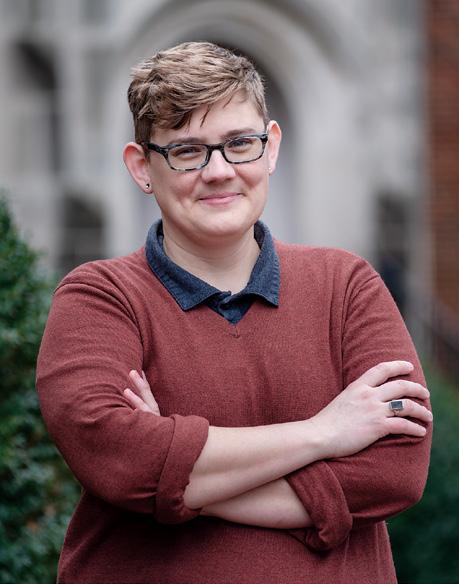
4 minute read
Signature
Treasuring Our Art
On the morning of Oct. 13, 1965, the Charles A. Dana Fine Arts Building was dedicated by Agnes Scott College’s then-President Wallace Alston “as an instrument of good teaching, creative achievement, and cultural enrichment for students and our friends in the larger community.” A blend of old and new, the building was designed by notable Southeastern architect John Portman, who included design elements such as the concrete folded plate roof and red bricks for the distinctive outer screen to convey the spirit of more traditional buildings on campus while working in conversation with modern elements to create what he intended to be “a cathedral to the arts.” The new building was named for philanthropist Charles A. Dana, and its galleries within honored Harry L. and Mary Keesler Dalton ’25, who made donations to support the growth of the college’s permanent collection of art.
As a first-year prospective theatre major and a graduated studio art major, I practically lived in Dana all four years of my time at Agnes Scott. It always surprises me that a building I know so well could be unknown to so many. Countless times I’ve greeted newcomers to the gallery and heard various iterations of the following exclamation: “I’ve walked/driven past this building so many times and had no idea there was a gallery here!” This always dismays and delights me, as Dana and The Dalton Gallery often remain hidden in plain sight to many, but they still uphold Alston’s dedication to students and community members who have spent time there. And, at one time, The Dalton Gallery was a hidden gem of Atlanta’s art scene, with many now well-known artists having enjoyed early career recognition through exhibitions there. (Check out the long history of acclaimed exhibitions at daltongallery.agnesscott.org).
Although the original intent of the gallery was a bit more formal, it has evolved into an extension of the Department of Art and Art History as a teaching space, allowing students to work under gallery leadership, assisting in all aspects of producing its exhibitions — from curating to giving public talks to repairing the walls to adjusting the lights between shows. These unique learning and leadership opportunities give students hands-on experience and prepare them for a variety of work in the professional art world. Being involved with the gallery also allows them to become well-versed on the art and artists in the college’s permanent collection.
Beyond the walls of Dana, the campus itself serves as a gallery for the permanent collection, and students are immersed in art during their everyday lives at Agnes Scott. Near the coffee bar in the Alston Campus Center, the work of well-known contemporary feminist artist Barbara Kruger looms large, enlivening the space with vivid renderings of green and growing plants and her signature bold white text on red blocks of color. A quiet, more contemplative collection of Japanese woodblock prints can be observed in the McCain Library, while works with a scientific or biological theme are most often found in the Mary Brown Bullock Science Center. Many buildings have a theme of sorts, and I could go on for pages and pages detailing in excess of 1,000 pieces in the permanent collection’s database. I don’t have any favorites to speak of, as they are all too varied in theme and importance to choose only one. A collection should be a living thing, and often these works are moved around the campus, creating new opportunities for reflection and conversation. When we are able to return safely to our campus, take the time to notice the art around you. It has been placed with the intention of providing education and enrichment.
Perhaps I am biased, but I believe there is nothing more important than the art a culture produces. The art and art spaces of our campus are a gift left by those who came before us and a gift we are duty-bound to provide proper care and stewardship of, as they are an important part of our legacy. We must treasure our college’s collected art and artifacts that offer us an interdisciplinary history, rich with community, identity and thoughtful engagement with the social and intellectual challenges of our times. — Leah Owenby ’01
Leah Owenby ’01 has worked in faculty services at Agnes Scott College since 2012, and she is currently the faculty events coordinator and administrative assistant to the Department of Music. Owenby earned a bachelor’s degree in studio art at Agnes Scott and is the former manager of The Dalton Gallery and permanent collection. She serves on the board of the Decatur Arts Alliance, is an actively working and sometimes exhibiting artist and lives with her wife, Katie Rubesch Owenby ’05, and their well-intentioned but often ill-behaved dogs in Decatur, Georgia.
Header photo by Tom Meyer









